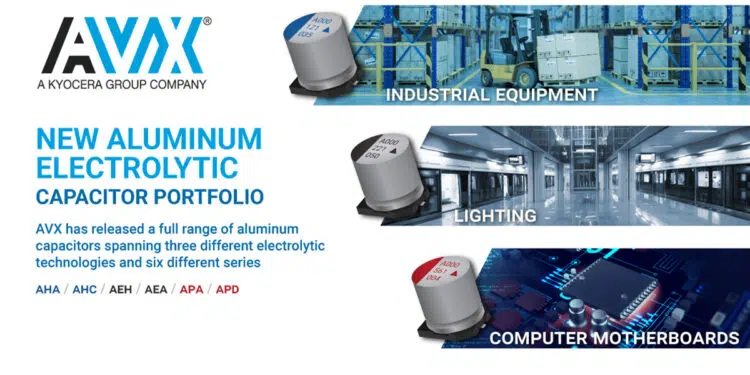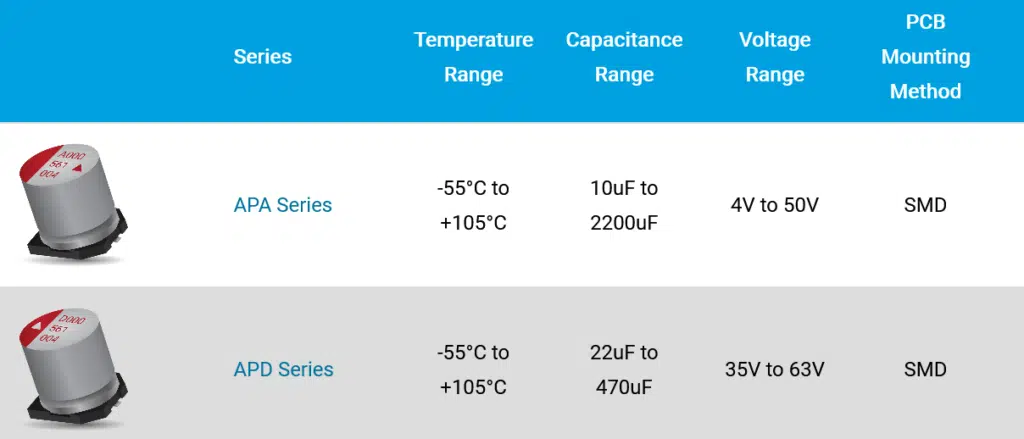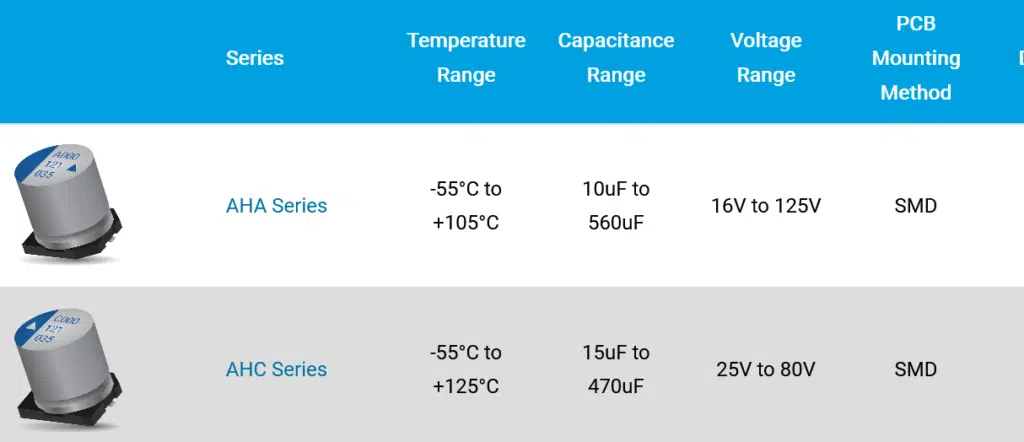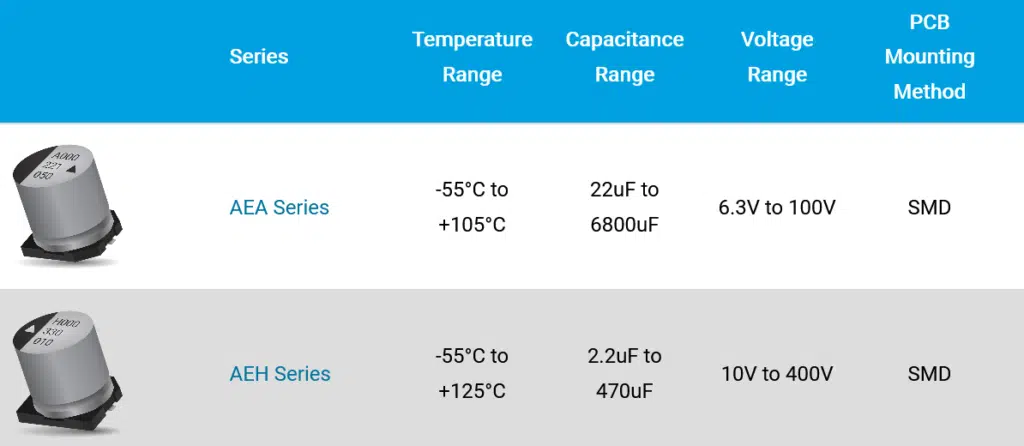Adding a ninth capacitor type to AVX’s already-extensive capacitor product portfolio, these six new series of surface-mount aluminum chip capacitors feature three different electrolytic technologies, deliver high-CV, low-ESR performance in competitively compact and cost-effective form factors, and offer a whole new slate of high-endurance solutions ideal for use in a broad range of consumer and industrial electronics applications.
AVX Corporation, a leading manufacturer and supplier of advanced electronic components and interconnect, sensor, control, and antenna solutions, has released a full range of aluminum capacitors spanning three different electrolytic technologies and six different series. This new range of surface-mount aluminum chip capacitors add a ninth capacitor type to AVX’s already-extensive capacitor product portfolio, which also includes broadband, ceramic, niobium oxide, polymer, film, RF/microwave, tantalum, and supercapacitor technologies. As such, these six series will provide customers with a whole new slate of high-endurance solutions that exhibit low ESR and high capacitance and voltage (high-CV) characteristics in competitively compact and cost-effective form factors ideally suited for use in a broad range of consumer and industrial electronics applications.
AVX’s new range of surface-mount (SMT) aluminum chip capacitors is currently comprised of two aluminum electrolytic capacitor series: the AEA and AEH Series, two conductive polymer aluminum electrolytic capacitor series: the APA and APD Series, and two hybrid aluminum electrolytic capacitor series. Shared characteristics of the six series include high-CV performance in smaller packages than competing can-type aluminum capacitors, very low equivalent series resistance (ESR), high endurance, and compatibility with lead-free and RoHS requirements. Specialized characteristics of the conductive polymer and hybrid electrolytic solutions include smaller case sizes and higher tolerance for ripple currents, inrush currents, and high temperatures than standard aluminum electrolytic solutions.
“The AVX team is very pleased to announce the addition of aluminum capacitors to its already-extensive portfolio of high-performance electrolytic capacitors with the official release of our new range of aluminum chip capacitors,” said Allen Mayar, AVX Electrolytic Capacitors global product manager. “These six new series are especially designed to meet increased market demand for compact and cost-effective aluminum capacitors that exhibit high capacitance and voltage characteristics, very low ESR, and high endurance, and are optimized for use in a wide range of high-density and high-temperature consumer and industrial electronics applications.”
AEA Series SMT aluminum electrolytic capacitors are currently available in four case sizes (0810, 1010, 1213, and 1616) with capacitance values and voltage ratings spanning 22–6,800μF and 6.3–100VDC. They are rated for operating temperatures extending from -55°C to +105°C, exhibit low impedance and reliably withstand 5,000 hours at 105°C, and are especially well suited for lighting and DC/DC converter applications in consumer and industrial electronics.
AEH Series SMT aluminum electrolytic capacitors are currently available in 10 case sizes (0608, 0810, 0813, 1010, 1012, 1013, 1016, 1213, 1216, and 1616) with capacitance values and voltage ratings spanning 2.2–1,500μF and 10–450VDC. They are rated for operating temperatures extending from -55°C to +125°C (10–100V) or -40°C to +125°C (160–450V), reliably withstand 2,000 to 5,000 hours at 125°C, and are especially well suited for use in DC/DC converters with high-density PCBs in high-temperature environments.
APA Series SMT conductive polymer electrolytic aluminum capacitors are currently available in nine case sizes (0606, 0607, 0608, 0609, 0807, 0809, 0812, 1010, and 1012) with capacitance values and voltage ratings spanning 10–2,200μF and 4–50VDC. They are rated for operating temperatures extending from -55°C to +105°C, exhibit super-low ESR and reliably withstand 5,000 hours at 105°C, and are especially well suited for use in DC/DC converters, voltage regulators, decouplers, and computer motherboards.
APD Series SMT conductive polymer electrolytic aluminum capacitors are currently available in five case sizes (0606, 0609, 0809, 0811, and 1012) with capacitance values and voltage ratings spanning 22–470μF and 35–63VDC. They are rated for operating temperatures extending from -55°C to +105°C, reliably withstand 2,000 hours at 105°C, and are especially well suited for use lamps, LEDs, and power supplies.
AHA Series SMT hybrid electrolytic aluminum capacitors are currently available in four case sizes (0608, 0810, 1010, and 1012) with capacitance values and voltage ratings spanning 10–560μF and 16–125VDC. They are rated for operating temperatures extending from -55°C to +105°C, reliably withstand 2,000 to 10,000 hours at 105°C, and are especially well suited for use in industrial equipment.
AHC Series SMT hybrid electrolytic aluminum capacitors are currently available in five case sizes (0608, 0609, 0810, 0812, and 1010) with capacitance values and voltage ratings spanning 15–470μF and 25–80VDC. They are rated for operating temperatures extending from -55°C to +125°C, exhibit ultralow ESR and high ripple current resistance, reliably withstand 4,000 hours at 125°C, and are especially well suited for use in commercial and industrial power supplies that require high capacitance in energy-dense, small-volume packages.
The new aluminum electrolytic portfolio release will proceed in several different phases. AVX introduced the Standard, Polymer, and Hybrid aluminum chip capacitors in the initial release and will continue expanding upon the new range in the future. In fact, AVX already has several new case sizes, capacitance values, and voltage ratings in development for both the AEH Series and the AHC Series. Lead-time for these six new aluminum chip capacitor series is currently 18–20 weeks.

































